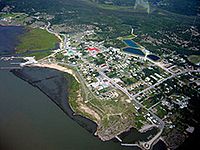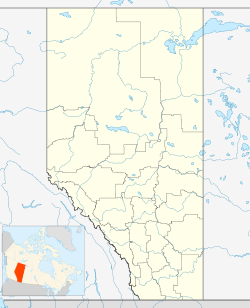- Fort Chipewyan, Alberta
-
Hamlet of Fort Chipewyan — Hamlet — Aerial view of Fort Chipewyan Location of Fort Chipewyan in Alberta Coordinates: 58°42′52″N 111°09′30″W / 58.7144°N 111.1583°W Country  Canada
CanadaProvince  Alberta
AlbertaRegion Northern Alberta Census division 16 Specialized municipality R.M. of Wood Buffalo Settled 1788[1] Government – Type Unincorporated – Mayor Melissa Blake – Governing body Wood Buffalo Municipal Council- Mike Allen
- David Allen Blair
- Sonny Flett
- Sheldon Germain
- Dave Kirschner
- Phil Meagher
- Don Scott
- Jane Stroud
- Russel Thomas
- Allan Glenn Vinni
Area – Total 10.24 km2 (4 sq mi) Elevation 220 m (722 ft) Population (2007)[2] – Total 1,007 Time zone MST (UTC-7) Postal code T9K Area code(s) +1-780 Fort Chipewyan, commonly referred to as Fort Chip, is a hamlet in northern Alberta, Canada within the Regional Municipality (R.M.) of Wood Buffalo.[3] It is located on the western tip of Lake Athabasca, adjacent to Wood Buffalo National Park, approximately 223 kilometres (139 mi) north of Fort McMurray.
Fort Chipewyan is one of the oldest European settlements in the Province of Alberta. It was established as a trading post by Peter Pond of the North West Company in 1788.[1] The Fort was named after the Chipewyan First Nation living in the area. One of the establishers of the Fort, Roderick McKenzie, always had a taste for literature, as was seen years later when he opened correspondence with traders all over the north and west, asking for descriptions of scenery, adventure, folklore and history. He also had in view the founding of a library at the fort, which would not be only for the immediate residents of Fort Chipewyan, but for traders and clerks of the whole region tributary to Lake Athabaska, so that it would be what he called, in an imaginative and somewhat jocular vein, "the little Athens of the Arctic regions." This library became, perhaps, the most famous in the whole extent of Rupert's Land.[4][5][6]
Contents
Economy
Tourism plays a key role in Fort Chipewyan's economy, especially in the summer months.
Demographics
The population of Fort Chipewyan according to the R.M of Wood Buffalo's 2007 municipal census is 1,007,[2] which makes the hamlet eligible for town status.[7] The subsequent 2008 municipal census recorded a population of 1,016.[8] However, with the overall 2008 municipal census result for the R.M. of Wood Buffalo not being accepted by Alberta Municipal Affairs due to the use of extrapolation,[9] Therefore, Fort Chipewyan's 2008 population may be more of an estimate compared to its 2007 figure.
The hamlet had a population of 902 living on a land area of 10.24 square kilometres (3.95 sq mi) as of the 2001 census.[10]
The hamlet's population is predominantly made up of Cree First Nations, Chipewyan (Dene) First Nations, and Metis people.
Transportation
Air
The hamlet is served by the Fort Chipewyan Airport. Air is one of two methods of access to Fort Chipewyan in the summer.[11]
Water
In the summer, the hamlet also can be accessed by boat[11] from Fort McMurray via the Athabasca River.
Road
There are no all-weather roads to Fort Chipewyan, but it can be reached via winter roads in the winter.[11] These include roads from Fort Smith to the north and from Fort McMurray to the south. Although the Alberta government has previously conducted studies on all-weather road access, no action has been taken.[citation needed] In December 2005, one-third of Fort Chipewyan's residents signed a petition to request the government to build a 50 km (31 mi) all-weather road to connect with existing roads to the northwest that provide access to Fort Smith, Northwest Territories.[citation needed] The major expenditure would be a bridge over the Slave River.
Climate
Fort Chipewyan has a subarctic climate (Köppen Dfc) with long, very cold, dry winters and short, warm, wetter summers..
Climate data for Fort Chipewyan Month Jan Feb Mar Apr May Jun Jul Aug Sep Oct Nov Dec Year Record high °C (°F) 10.5
(50.9)11
(52)14.5
(58.1)27.1
(80.8)32
(90)34.4
(93.9)34
(93)34
(93)29
(84)26.5
(79.7)17
(63)8.8
(47.8)34.4
(93.9)Average high °C (°F) −17.6
(0.3)−13.3
(8.1)−5
(23)5.8
(42.4)14.8
(58.6)20.2
(68.4)22.6
(72.7)20.7
(69.3)13.3
(55.9)5.1
(41.2)−6.8
(19.8)−15.2
(4.6)3.7 Daily mean °C (°F) −23.2
(−9.8)−19.3
(−2.7)−11.8
(10.8)−0.1
(31.8)8.6
(47.5)14.2
(57.6)16.7
(62.1)14.8
(58.6)8.2
(46.8)0.8
(33.4)−11.3
(11.7)−20.5
(−4.9)−1.9 Average low °C (°F) −28.7
(−19.7)−25.2
(−13.4)−18.6
(−1.5)−6
(21)2.4
(36.3)8.1
(46.6)10.7
(51.3)8.9
(48.0)3.2
(37.8)−3.5
(25.7)−15.7
(3.7)−25.8
(−14.4)−7.5 Record low °C (°F) −50
(−58)−46.7
(−52.1)−43.5
(−46.3)−34.1
(−29.4)−10.6
(12.9)−4
(25)−0.9
(30.4)−4.2
(24.4)−12.2
(10.0)−30
(−22)−39
(−38)−47.8
(−54.0)−50
(−58)Precipitation mm (inches) 19.3
(0.76)15.7
(0.618)17.8
(0.701)18.5
(0.728)25.3
(0.996)51.7
(2.035)70.8
(2.787)47.6
(1.874)38.4
(1.512)34
(1.34)29.1
(1.146)23.7
(0.933)391.9
(15.429)Source: Environment Canada[12] See also
- List of communities in Alberta
- List of hamlets in Alberta
References
- ^ a b Athabasca Tribal Council - Athabasca Chipewyan First Nation
- ^ a b R.M. of Wood Buffalo (2007). "2007 Municipal Census Report". http://www.woodbuffalo.ab.ca/business/demographics/pdf/2007_census_RMWB.pdf. Retrieved February 14, 2009.
- ^ Alberta Municipal Affairs (2010-04-01). "Specialized and Rural Municipalities and Their Communities". http://municipalaffairs.gov.ab.ca/documents/msb/2010-ruralmun.pdf. Retrieved 2010-07-10.
- ^ The Rev George Boyce, MacKenzie - Selkirk - Simpson - The Makers of Canada[1]
- ^ http://www.electricscotland.com/history/canada/makers/mackenzie3.htm
- ^ Campbell, Wilfred; Bryce, George, "The Scotsman in Canada", Toronto, Musson Book Co.,1911[2]
- ^ Alberta Queen's Printer. "Municipal Government Act". http://www.qp.alberta.ca/574.cfm?page=m26.cfm&leg_type=Acts&isbncln=9780779745739. Retrieved June 17, 2010.
- ^ R.M. of Wood Buffalo (July 15, 2009). "2008 Municipal Census Report". http://www.woodbuffalo.ab.ca/business/demographics/pdf/2008_municipal_census.pdf. Retrieved February 14, 2009.
- ^ R.M. of Wood Buffalo (July 15, 2009). "Wood Buffalo’s population passes 100,000, reports 2008 Municipal Census". http://www.woodbuffalo.ab.ca/municipal_government/media_releases/2009/july15.census.asp?subnav=161. Retrieved February 14, 2009.
- ^ Statistics Canada (Census 2001). "Wood Buffalo Regional Municipality - Population counts". http://www12.statcan.ca/english/census01/products/standard/popdwell/Table-CD-DPL.cfm?T=2&PR=48&CD=4816&CSD=4816037&SR=1.
- ^ a b c "Fort Chipewyan". Regional Municipality of Wood Buffalo. http://www.woodbuffalo.ab.ca/living_2227/Communities/Fort-Chipewyan.htm. Retrieved 2011-09-28.
- ^ Environment Canada Canadian Climate Normals 1971–2000, accessed 24 July 2009

Wood Buffalo National Park Fort Smith Uranium City 
Wood Buffalo National Park 
Lake Athabasca  Fort Chipewyan
Fort Chipewyan 

Lake Claire Fort Mackay
Fort McMurray Subdivisions of Alberta
Subdivisions of AlbertaSubdivisions Regions · Census divisions · Municipal districts (counties) · Specialized municipalities · School districts · Regional health authoritiesCommunities Cities · Towns · Villages · Summer villages · Hamlets · Indian reserves · Métis settlements · Ghost towns · Designated placesCities and Urban
Service AreasAirdrie · Brooks · Calgary · Camrose · Cold Lake · Edmonton (capital) · Fort McMurray · Fort Saskatchewan · Grande Prairie · Lacombe · Leduc · Lethbridge · Lloydminster · Medicine Hat · Red Deer · Sherwood Park · Spruce Grove · St. Albert · WetaskiwinCoordinates: 58°42′52″N 111°09′30″W / 58.71444°N 111.15833°W
Categories:- Hamlets in Alberta
- National Historic Sites in Alberta
- North West Company
- Designated places in Alberta
- Wood Buffalo, Alberta
- Hudson's Bay Company trading posts
- Fort or trading post National Historic Sites of Canada
Wikimedia Foundation. 2010.


